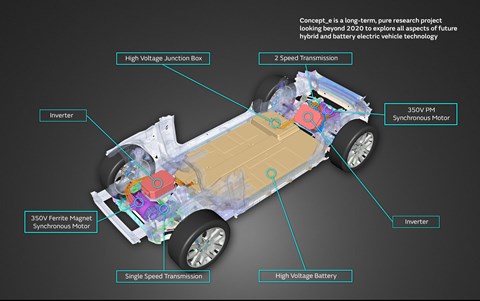► Three new concepts from JLR
► New e-motor powers future hybrids
► Plus lightweighting, new materials
Jaguar Land Rover is developing a raft of electric car tech to power the next generation of sports limousines and SUVs – along with clever-clogs gadgets such as ‘warm air blankets’ and flax-carbonfibre materials to trim weight.
The company today announced three new technology concept cars, premiering its new electric drive module (EDM) at the Cenex Low Carbon Vehicle summit in Bedfordshire. It’s a new, inhouse-developed motor claimed to be twice as powerful as any electric motor-generator in production today.
Electric Jags and Land Rovers available in all flavours
This is a modular e-motor that can be deployed in a pure electric vehicle or a variety of hybrids. Hence the three concept car shown today:
- Concept_e BEV This research demonstrator points to a standalone electric car. It’s 4wd, aluminium-bodied and has a 85kW front motor and 145kW rear motor
- Concept_e PHEV Showing how the same engine could power a plug-in hybrid Range Rover Sport, twinning 150kW e-motor with 300bhp V6 petrol and 4wd
- Concept_e MHEV A mild hybrid application based on a Range Rover Evoque: low-power Ingenium diesel engine, 15kW crank-integrated motor, 48v power

‘Our future vision is to continue to reduce emissions and improve fuel efficiency while still delivering the luxury, performance, refinement and comfort our customers expect,’ said Dr Wolfgang Epple, JLR’s head of research and development.
Air blankets, flax-based carbonfibre and more
As well as the trio of concept cars, JLR has also confirmed it is developing a host of new technologies to help trim its emissions and win the battle against CO2 and other pollutants. Its so-called Warm Air Blanket is a new heating and cooling system designed to cut in half the energy required to maintain the cabin temperature.
And it’s also working on a new blend of carbonfibre and flax – dubbed Carbio – which blends cashew nut oil resin into the mix. The material is claimed to be a third cheaper than pure carbonfibre – and 28% lighter than aluminium or 55% less than steel.